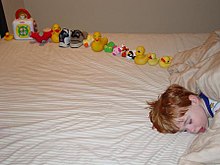
Back Outisme Afrikaans طيف التوحد Arabic Autismu AST اوتیسم اسپکتروم AZB Разлад аўтыстычнага спэктру BE-X-OLD Аутистичен спектър Bulgarian Poremećaj iz autističnog spektra BS Trastorn de l'espectre autista Catalan شەبەنگی ئۆتیسم CKB Poruchy autistického spektra Czech

The autism spectrum, often called just autism or autism spectrum disorder, refers to a disorder of brain development caused by differences in the structure of the brain.[1] Autism changes how someone thinks, understands the world, moves, communicates, and socializes. Autism is a spectrum disorder, which means that every person with autism will have different symptoms and different severity of symptoms.[2] Some autistic people may need a lot of help with one thing. Other autistic people may not need help with the same thing. It may be easy to tell when someone is autistic, or it may not be.[3]
The main areas of difference from non-autistic people is thinking differences (how people think and understand the world), sensory processing differences (how people react to stimuli), motor differences, communication differences, developmental differences, and socializing differences.[3]
Signs of autism are usually present when a child is around two or three, but some people are not diagnosed until later. Some people are not diagnosed until they are adults. There is no cure for autism and many autistic people do not want a cure.[4][5] They want to be accepted as different. This is called neurodiversity.[6][7] Autistic people who want their differences to be accepted may be part of the autism rights movement.
- ↑ CDC (2023-01-11). "Signs & Symptoms | Autism Spectrum Disorder (ASD) | NCBDDD | CDC". Centers for Disease Control and Prevention. Retrieved 2023-04-27.
- ↑ "Autism spectrum disorder - Symptoms and causes". Mayo Clinic. Retrieved 2023-04-27.
- ↑ 3.0 3.1 "What is autism? – Welcome to the Autistic Community". Retrieved 2023-01-26.
- ↑ Keating, Connor Tom; Hickman, Lydia; Leung, Joan; Monk, Ruth; Montgomery, Alicia; Heath, Hannah; Sowden, Sophie (2022-12-06). "Autism-related language preferences of English -speaking individuals across the globe: A mixed methods investigation". Autism Research. 16 (2): 406–428. doi:10.1002/aur.2864. ISSN 1939-3792. PMID 36474364. S2CID 254429317.
- ↑ "2. Autism is not a disease. You can't cure autism. – Welcome to the Autistic Community". Retrieved 2023-01-26.
- ↑ Silverman, Chloe (2008-09-01). "Fieldwork on Another Planet: Social Science Perspectives on the Autism Spectrum". BioSocieties. 3 (3): 325–341. doi:10.1017/S1745855208006236. ISSN 1745-8560. S2CID 145379758.
- ↑ "Autism - are we any closer to explaining the enigma? | The Psychologist". thepsychologist.bps.org.uk. Archived from the original on 2019-05-10. Retrieved 2021-01-31.
© MMXXIII Rich X Search. We shall prevail. All rights reserved. Rich X Search